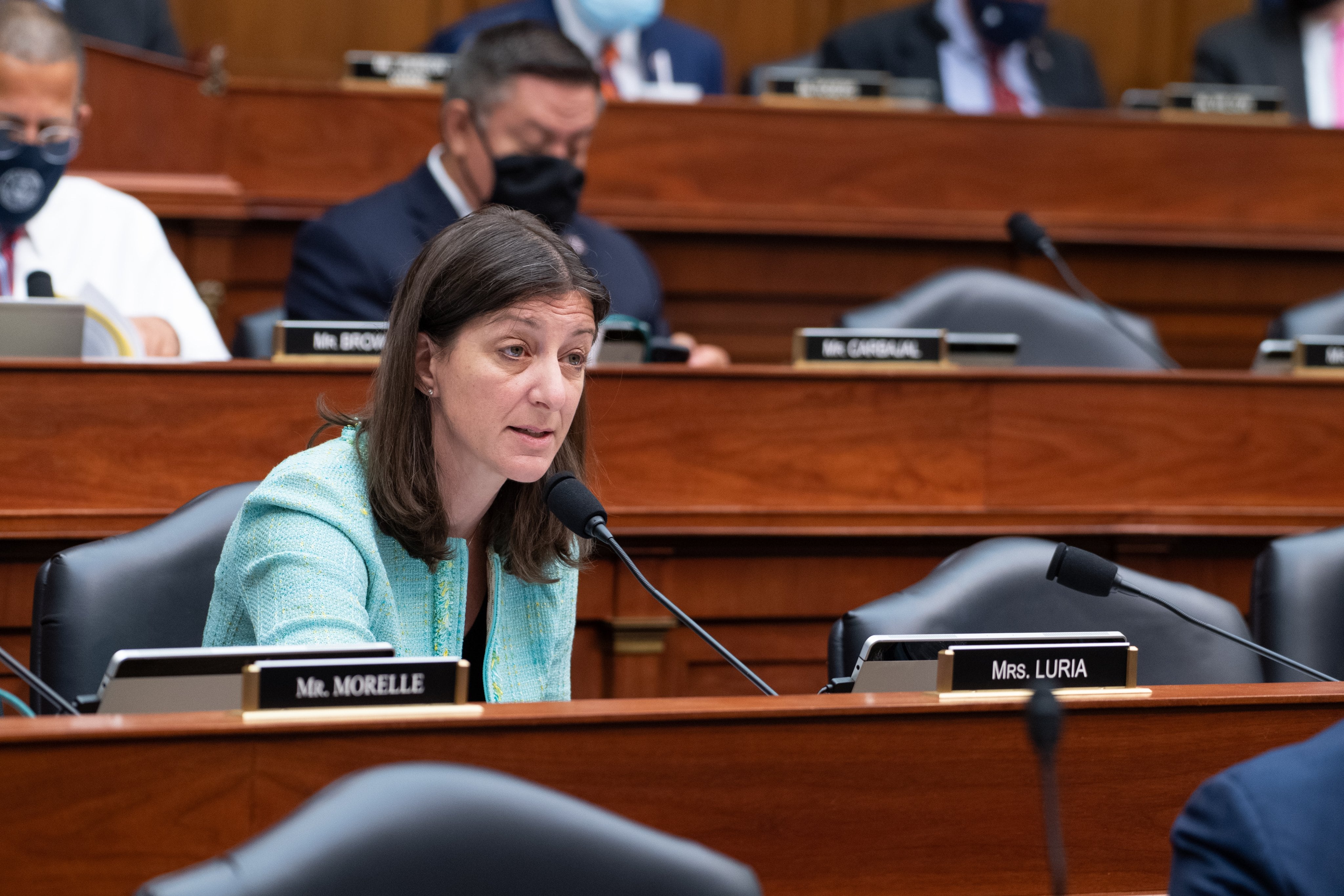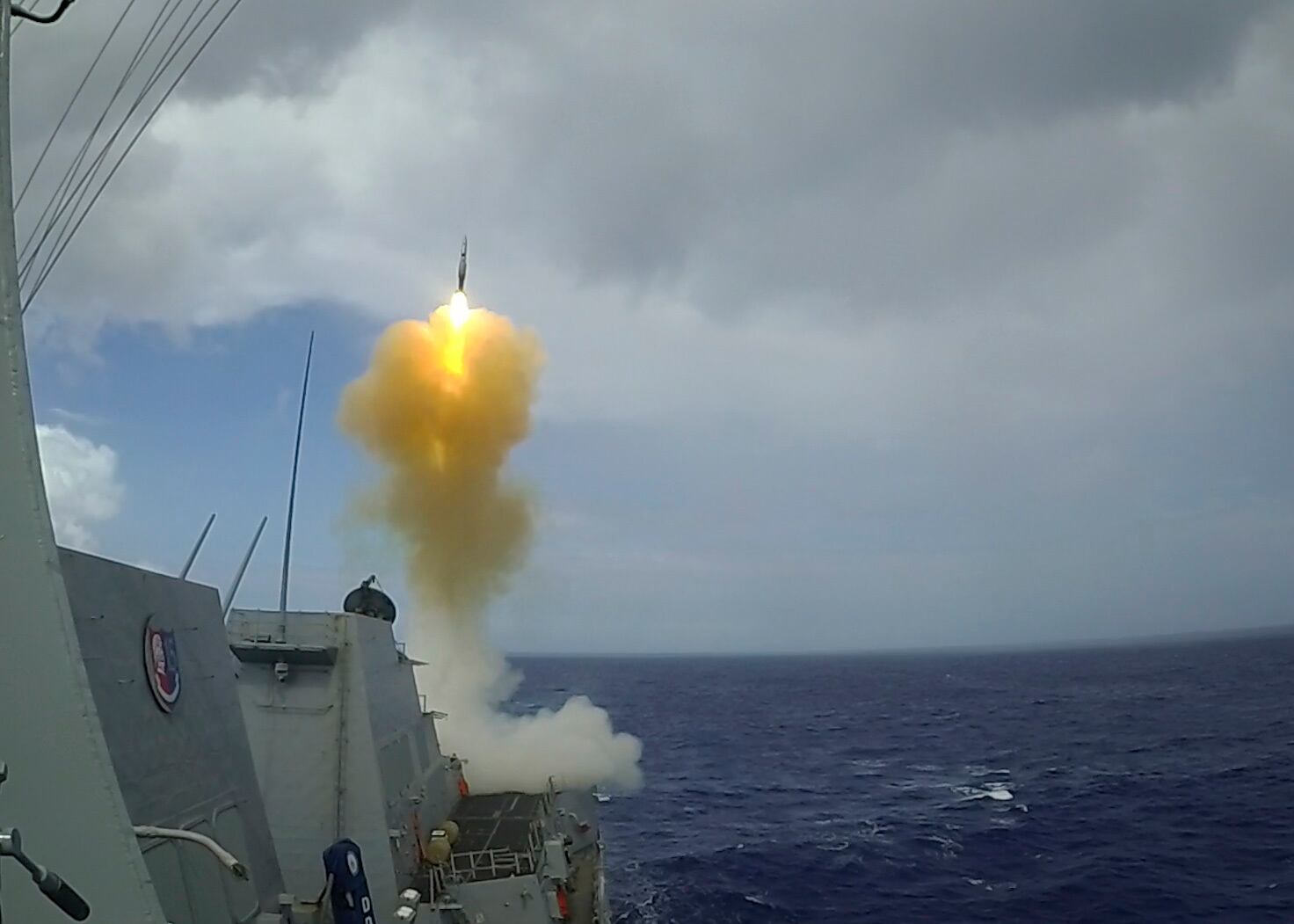WASHINGTON — Rep. Elaine Luria is one of the U.S. Navy’s staunchest proponents — and one of its most ruthless critics.
Luria first drew attention in 2018 as one of seven Democrats with national security backgrounds who flipped red House seats to blue. But the Virginian at times finds herself aligned with Republicans, as she champions defense spending hikes, even flatly saying earlier this year President Joe Biden’s defense budget “sucks.”
Now, the 46-year-old former Navy commander serving as the House Armed Services Committee’s vice chairwoman faces her toughest political battle yet as she works to hold onto her seat this fall.
To Democrats, Luria is a pivotal player in their quest to maintain a majority in the House — even as she finds herself at odds with fellow members of her party. To shipbuilders and sea power supporters, she’s an ally; to the Navy, she’s both a supporter and a skeptic. Last month, she led a bipartisan coalition to boost defense spending, and she often uses her military experience to grill officials on both the size and readiness of the Navy’s fleet, and whether those factors are sufficient enough to win a war against China.
It’s a role some Navy supporters say is much needed, as the service has borne the fallout from budget fights since 9/11 that favored the military branches closer to the wars in Iraq and Afghanistan.
Retired Navy Capt. Lory Manning, now the government relations director of the Service Women’s Action Network, said Luria is helping the Navy “make up for 20 years of being underfunded or under-resourced.”
“We need people like her who really know what they’re talking about with Navy ships because there’s not that many Navy officers in Congress, and they need to know they can’t bullshit,” Manning said.
It’s a focus Luria’s betting will resonate in Virginia’s 2nd District, home to a high concentration of shipyard workers, service members, veterans and their families. The district is adjacent to the Hampton Roads area, whose local economy is tied to Naval Station Norfolk, home of the most U.S. Navy personnel, and to Norfolk Naval Shipyard, which services nuclear-powered aircraft carriers and submarines on the East Coast.
“I spend the majority of my time talking about defense and veterans issues, and it affects everybody in my community,” Luria, who also serves on the House Veterans’ Affairs and Homeland Security committees, told Defense News during a June 24 interview in her office.
“The way I look at it is if we don’t get this right with defense, especially with China’s increased aggression against Taiwan, investing in the right Navy and air forces, none of the other stuff matters.”

More than two decades in the Navy
Luria is well known in defense circles for using her 20 years of Navy experience to scrutinize the sea service.
A Birmingham, Alabama, native, she entered the Navy at 17 after attending a U.S. Naval Academy summer science and engineering program during high school. She graduated from the academy in 1997 and was among the first women to serve in the Navy’s nuclear power program and to spend her career on combat ships before retiring in 2017.
In uniform, Luria capped a globe-spanning career as executive officer of the guided-missile cruiser Anzio and then as commander of Assault Craft Unit 2, which supplies amphibious forces on the East Coast. The Virginia-based command supplied ships for Hurricane Matthew relief in Haiti and the multinational exercise Cold Response in Norway, among other missions.
Luria and her husband, also a retired naval commander, opened and later sold a shop called the Mermaid Factory, where customers painted sculptures of mermaids, the symbol of Norfolk. By owning a business, Luria said, she became attuned to local, state and federal policy, and “was looking at ways to continue to serve” when she launched her successful campaign against incumbent Scott Taylor, a former Navy SEAL.
Luria is one of five self-described “badass” women among the 2019 class of national security-focused freshman Democrats. They were considered a new kind of candidate, the kind of moderate that might be able to win in a more polarized environment.
Another in that group, New Jersey Democratic Rep. Mikie Sherrill, a former Navy helicopter pilot, told Defense News this year’s reelection fights will be more difficult against an energized GOP.
“Elaine is a badass,” Sherill said. “She is on message. We might be talking about Ukraine or some concern we might have about our NATO allies, or the overuse of special operators, and Elaine Luria, without fail, no matter the context, will tell you why it’s important we don’t have enough ships and why we have to fight harder for that.”
While Luria is a generally reliable Democratic vote, she’s bucked the Biden administration to take stances on defense and shipbuilding primarily championed by Republicans.
The administration last year laid plans to stop spending money on weapons ill suited to a notional fight with Russia or China and to instead reinvest in forward-leaning technologies. But Congress reworked those plans as part of a $25 billion boost to defense spending. In response, the White House scolded lawmakers over budget bloat.
“The Administration opposes the direction to add funding for platforms and systems that cannot be affordably modernized given the need to eliminate wasteful spending and prioritize survivable, and resilient forces that credibly deter advanced threats,” the White House said in a policy statement in November.
For the past two defense budgets, Luria has rejected the administration’s plans and joined groups of Republicans and centrist Democrats to pass separate proposals, adding billions of dollars in funding.
In 2021, Luria was among centrist Democrats who supported a Republican amendment to increase Biden’s flat budget, which in turn helped Congress add two destroyers and rescue two ships planned for decommissioning.

This year, she co-sponsored Maine Democratic Rep. Jared Golden’s amendment to the House Armed Services Committee’s defense policy bill to add $37 billion for five more ships, among other hardware.
The boost included roughly $7.4 billion to cover inflation. It also added $3.6 billion for an additional destroyer, an additional frigate, an additional T-AO oiler and two expeditionary medical ships, as well as $2 billion for eight additional F/A-18 jets and other Navy and Marine Corps aircraft. It would save five of the nine littoral combat ships the Navy wants to retire early because they’re not suited to high-end fights.
HASC Chairman Adam Smith, D-Wash., and a critic of ever-rising defense budgets, denounced the $37 billion increase his panel passed 42-17. But Smith said he’s not rankled to have opposition from a fellow Democrat on what’s arguably the committee’s defining issue.
Luria, among 14 veterans on the committee from both sides of the aisle, is “incredibly effective,” Smith said.
In a sign of HASC’s unique bipartisanship, Smith and Rep. Mike Rogers, the committee’s top Republican, had a hand in crafting the amendment before it was proposed.
Smith said “Elaine was a crucial part of that process, of getting to the right amounts.”
Tough questions
Luria is one of the House Armed Services Committee’s most biting inquirers, especially when it comes to Navy matters. Less than a year into office, she grilled service officials on complex issues, often with coolly withering or rapid-fire questions, rarely glancing at her notes.
At a naval readiness hearing in 2019, Luria peppered the three-star chief of Naval Sea Systems Command with questions about maintenance delays for carriers.
Though Navy plans called for the carrier George H.W. Bush to sit in drydock for 16 months of a 36-month cycle, Luria wanted to know why it would instead take 28 months, forcing another carrier to extend its deployment.
NAVSEA’s commander said the Bush faced unique repair issues and that Norfolk was overburdened by other work. Luria told him she’d talked to the shipyard commander personally; the work didn’t seem unique to her.
“Are you going to say it was successful if we complete it in 28 months, or is it already a failure because it’s 28 instead of 16, which it should have been?” Luria asked pointedly.
The larger issue to her was that seven out of 11 Navy carriers were not deployable, including the problem-plagued carrier Gerald R. Ford. She roasted that ship as “a $13 billion nuclear-powered berthing barge.”
Luria has also regularly argued Navy officials do not advocate enough for their service and budget. She has criticized the Navy for backtracking on plans to build a 355-ship fleet.
For their part, service officials have said fleet size is not all that matters. Chief of Naval Operations Adm. Mike Gilday and Navy Secretary Carlos Del Toro have, for example, tried to convince Congress to let the service decommission its old and worn-out cruiser fleet, arguing the ships are irrelevant to future fights, unsafe and a drag on the Navy’s budget.
“They’re eating us alive in terms of our ability to get maintenance back on track, which is where we need to be,” Gilday said at an industry event in March. “We are paying tens of millions of dollars beyond what we expected to because of growth work and new work on ships that are beyond their service life.”
To be clear, Luria hasn’t called for a specific number of ships; she agrees with the sort of aim Michèle Flournoy — former undersecretary of defense for policy — has espoused, that the U.S should be able to “credibly threaten to sink all of China’s military vessels, submarines, and merchant ships in the South China Sea within 72 hours.”
“With such a defined goal, we could design a fleet not based on size, but based on capability,” Luria said in 2020. “Deterrence must be credible and is only effective when an adversary believes, through our daily actions, that the cost of their armed aggression will be met with such overwhelming force (damage) that the loss would be too extreme for the benefit.”
Hawkish on China
Republicans in Washington have sought to paint Democrats as weak on China, but it’s hard to draw a line between those Republicans and Luria, who has called on the Biden administration to end U.S. ambiguity about whether it would defend Taiwan against a Chinese attack.
When Navy officials appeared on Capitol Hill last year to defend plans to decommission 15 ships, Luria was among lawmakers who pointed to assessments from two successive Indo-Pacific Command chiefs that China wants to be able to seize Taiwan by 2027. Beijing considers the island a breakaway province and has vowed to incorporate it back into the mainland, by force if necessary.

The U.S. Navy’s focus on the future, Luria and other lawmakers said, would leave it too small to face that fast approaching threat.
“We’re looking at this Battle Force 2045, a plan that’s far off, a 355-ship goal that we’re never going to get to when we decommission more ships every year than we actually build. … What are we going to do in 2025 to counter this threat?” Luria asked. “We’re creating a gap, and I’m afraid that the Chinese will find a way to exploit that gap.”
When this year’s budget proposal aimed to retire 24 ships, Luria made headlines in April for calling it out in a Twitter thread that invoked Taiwan.
“The Navy owes a public apology to American taxpayers for wasting tens of billions of dollars on ships they now say serve no purpose,” she said, adding the Navy has “NO PLAN” to replace lost firepower quickly enough to make a difference against China. “Lastly, the Navy has no strategy. Stop saying you do, because if you did you would be able to explain how this Fleet size will allow us to defend Taiwan.”
Luria followed up with a lengthy analysis published by the Center for International Maritime Security that decried the “catastrophic loss” of firepower she said would result from that budget.
According to Luria’s number crunching, those plans would translate into a loss of MK 41 Vertical Launching System cells, which fire a variety of missiles. She forecast a loss of 756 cells by 2024, 1,668 cells by 2027 and 1,980 by 2035.

To convince China it can’t outgun the U.S. and its allies in the Pacific region, Luria offered several options, including keeping and extending the lives of 12 cruisers, refitting expeditionary fast transport ships with a 64-cell capacity, and building eight additional ships.
That approach has won her plaudits from some Republicans.
Republican Rep. Mike Gallagher, a former Marine intelligence officer on the House Armed Services Committee, is a frequent collaborator. Also a China and sea power hawk, Gallagher was Luria’s co-sponsor on an amendment to establish a congressional commission to review the Navy’s force structure plans.
“She’s really knowledgeable and wants to build a bigger Navy,” said Gallagher, crediting her as the committee’s most vocal member about the Navy’s shrinking firepower. “I feel like we’ve done a billion amendments together.”
Luria’s budget inspiration stems from the Reagan administration. Then-Navy Secretary John Lehman’s 600-ship plan was meant to signal strength to the Soviet Union. As Luria sees it, the Democrat-run White House no longer grasps the urgency of a bigger naval budget, and the Navy’s not helping its own case.
“The administration was not prioritizing this with that sense of urgency and view, so I just continue to be loud about it,” Luria said. “I know that it’s frustrating to people in the administration that here you have a Democrat just continuously criticizing the administration on defense-related things.”
The previous Republican administration said “the right words,” she added, when then-Defense Secretary Mark Esper unveiled plans to boost the Navy’s fleet to 500 manned and unmanned ships by 2045, and a fleet of 355 traditional battle force ships by 2035.
Still, in October 2020, it came too late, she said.
“It was a commitment to an investment,” Luria said. “It needs to come from the top … and I just don’t feel like it’s been high enough of a priority.”
Though Biden has signed a flurry of executive orders that seek to revive America’s manufacturing and industrial base, the Navy’s budget submission is out of step and doesn’t offer any certainty of consistent work for shipbuilders, according to Luria.
“If we really want to make a commitment to grow the industrial base, we have to send a steady demand signal about what we are going to build,” she said.
Swing district
Luria wants a chance to craft that signal. But it will require winning another election.
The contest for Virginia’s 2nd District is a key part of the GOP’s drive to recapture the House, and it will be among the most closely watched in the country. Redistricting in 2021 means it tilts at six points in Republicans’ favor, according to FiveThirtyEight.
Luria maintains her record in Congress now positions her better than in past races. She pointed to her efforts to expand care to veterans exposed to toxic chemicals, win federal funding to improve rural 911 coverage, deepen Norfolk’s harbor and, of course, boost defense spending.
Republicans think they can beat Luria with State Sen. Jen Kiggans, a nurse practitioner who served as a Navy helicopter pilot. Kiggans, who prevailed in the GOP primary June 21 with the backing of House Minority Leader Kevin McCarthy, used her victory speech to link Luria to Biden.
“Every one of Joe Biden’s disastrous policies are on the ballot this November, and in the 2nd District, these policies go by the name of Elaine Luria,” said Kiggans, 51. “From $5-a-gallon gasoline to runaway inflation, and from an open border to Afghanistan and the Ukraine, Elaine Luria has been Joe Biden’s chief enabler.”

It’s unclear whether Luria’s work as a member of the House committee investigating the Capitol insurrection will be a liability in her Republican-leaning district. A majority of voters across Virginia, 68%, say Biden’s election was legitimate, but 26% disagree, according to polling last year by Christopher Newport University, based in Newport News.
An Associated Press poll released last month found that 48% of Americans think former President Donald Trump should be charged with a crime for his role in the events of Jan. 6, 2021. However, 86% of Democrats support criminal charges, while 68% of Republicans oppose them.
Luria said her service on the investigative panel marks a “clear contrast” with Kiggans, who was not definitive when recently asked by reporters whether Biden won in 2020.
“I’ll say this,” Kiggans told Virginia’s WTKR News, “Joe Biden lives in the White House, and I wish that he didn’t.”
Speaking with Defense News — just days before the committee heard testimony Trump rebuffed his own security detail’s warnings about armed protesters and made attempts to join them — Luria said the panel’s findings are more important than her reelection. “I feel that more and more the further we go along in this investigation,” she said.
To be sure, Luria said she definitely does want to be reelected. Among other plans, she’s working on a proposal to reform the Goldwater-Nichols Department of Defense Reorganization Act of 1986 in a way that she says would take the handcuffs off Navy budgeting.
“If I come back, you know, I’ve got a six- or eight-year plan,” she said. “There’s a lot of work to be done, and I think I’ve laid the groundwork.”
Joe Gould was the senior Pentagon reporter for Defense News, covering the intersection of national security policy, politics and the defense industry. He had previously served as Congress reporter.





